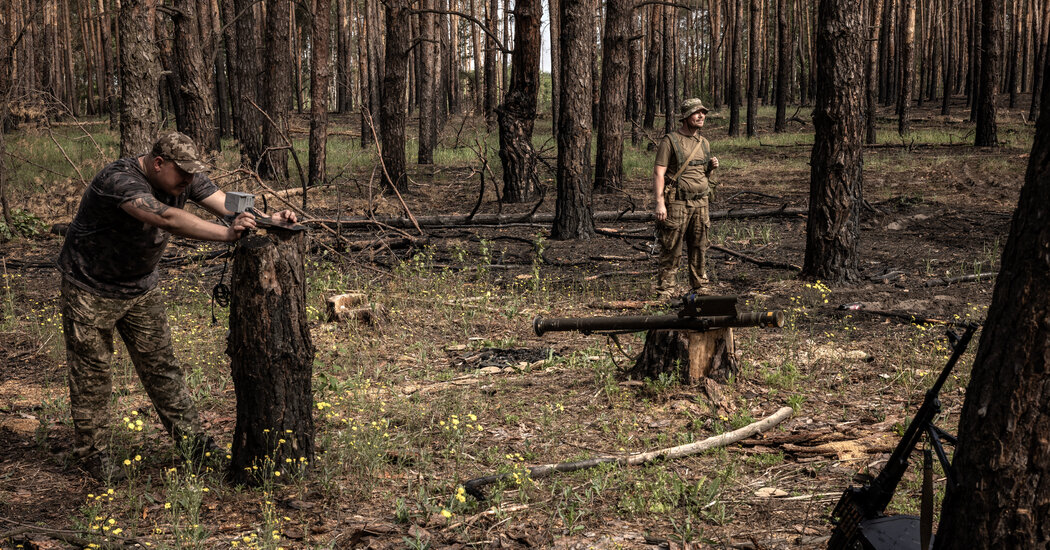Meeting with President Biden in France Gaining support Soldiers and commanders said in interviews that ammunition and weapons from an aid package approved by the U.S. Congress this spring to help Ukraine confront Russia are arriving to the front lines in quantities that can help stabilize defenses.
However, Russia still has an artillery advantage, which played a key role in the war in Ukraine.
Lieutenant Denis Yaroslavsky, a commander in northeastern Ukraine, where Russian troops attacked across the border last month and threatened to advance toward Kharkiv, Ukraine's second-largest city, said Thursday that Ukrainian artillery can now fire more frequently at Russian troops.
The Russian offensive has largely stalled. But in Ukraine's Donbas region south of Kharkiv, Russia has again launched an offensive against Ukrainian defenses.
Despite the intense and bloody fighting, overall there has been no significant change on the front line in more than two weeks, according to soldiers on the front line, military reports and satellite imagery. Battlefield Map Compiled by independent monitoring groups.
Here is the situation on the battlefield.
Kharkiv region
Following Russia's cross-border attack on northeastern Ukraine on May 10, there are concerns that Russian troops could move into Kharkiv, or at least get within artillery range of the city. Placing artillery such as howitzers near Kharkiv would allow Russian forces to bomb the city more heavily and effectively. Currently, Russia has to rely on longer-range aerial bombs and missiles, which are more expensive than artillery shells.
But to get within artillery range, Russian troops would need to advance at least once more, as they have done over the past three weeks.
Russian forces advanced about six miles into Ukrainian territory but became bogged down when they ran into more heavily defended Ukrainian positions, according to Ukrainian commanders. The commanders also said more Ukrainian troops had arrived to stop the Russian advance and more U.S. ammunition had reached frontline positions.
Lieutenant Yaroslavsky said in an interview that as of last week, Ukrainian forces had enough ammunition to hold Russia in its current position. “Our artillery fire is hitting Russian troop concentrations,” he said.
Fighting was heaviest in the streets of Vovchansk, a town divided between the two armies about four miles south of the Russian border that was deserted and largely destroyed after four weeks of fighting, according to the Kharkiv region's military administration.
Still, Lieutenant Yaroslavsky said Ukraine might be able to hold its soldiers’ positions in the town, where they are fighting in basements and the rubble of buildings, by attacking inside Russia to disrupt nearby Russian logistics. Last week, the Biden administration joined Ukraine’s six other Western allies in changing policy. Allowing such strikes Using the weapons they provided to the Ukrainian army.
“Before, our artillery units were very cautious with the number of shells and would not try to fire at only a few Russian soldiers,” said Lieutenant Yaroslavsky. He said the artillery units had changed their strategy and were now again targeting attacks by small Russian units on Ukrainian defenses.
Oleksandr Buktar, a Ukrainian National Guard lieutenant fighting near the village of Lyptsi, said he was awakened by a radio message around 7 a.m. Wednesday: A unit of seven Russian soldiers had reached the Ukrainian trenches and a gunfight was underway. In an interview, he described the fighting as common. “We were attacked by infantry two or three times a day,” he said.
Lieutenant Buktar said he deployed a trained response, stressing the importance of the artillery shells. He ordered a drone to fly over the trenches, then ordered his artillery to attack the area in front of the Ukrainian trenches, where Russian troops were advancing. “We used everything we had,” he said of the artillery shells.
Donbass region
Ukrainian and Western military analysts believe that Russia's strategy of opening a new front north of Kharkiv is aimed at dispersing Ukraine's limited military forces and weakening the defenses of the industrial and agricultural regions of Donbas in the south.
Russian troops have been advancing toward the region at a small, slow but bloody pace.
back Capture of the Donbass city of Bakhmut A year earlier, Russian troops advanced about three miles across open fields to the eastern edge of the town of Chasiv Yar, but then stalled near an irrigation canal.
defend Chasif Yar Hasif Yar is seen as strategically important because of its location on high ground, and losing it would open the door for Russia to push further into larger communities to the west and north. The last Russian ground operation into Hasif Yar was last week, according to satellite maps of the battlefield.
Rob Lee, a senior fellow at the Foreign Policy Research Institute's Eurasia Program, said the lull showed that Russian forces “did not fully exploit the Kharkiv Offensive, even though they succeeded in forcing Ukraine to redeploy some of its forces from Donbass.”
According to satellite maps, southern Donbass has been the area where the most intense fighting has occurred in recent weeks.
go through Capture of Avdiivka In February, the Russians broke through the first line of defense and have been advancing ever since, capturing village after village. They have yet to reach the second Ukrainian line of defense near the village of Karlivka.
According to Ukrainian soldiers, Russian troops made another small advance in the direction near the village of Sokil during the night of Wednesday to Thursday.
In that engagement, Russian troops in armored personnel carriers attacked Ukrainian defenders near Sokil. Soldiers from Ukraine’s 47th Brigade tried to fight back with U.S.-supplied Bradley infantry fighting vehicles, according to a sergeant from the brigade, who asked to be identified by his call sign, “Sapsan.” But the Bradley’s gun malfunctioned, and the Russians dismounted and attacked the position.
Sapsan said it was an example of a Russian strategy of launching probing attacks to look for weaknesses. He said such attacks are usually a “one-way ticket” for the soldiers involved. But he added that they provide Russia with intelligence to prepare for an attack by a larger force.
“They always do this, attack our positions and are willing to destroy armored personnel carriers and personnel,” he said, referring to Russian losses. Compared to the fighting north of Kharkiv, Russia also launched larger battalion-level attacks in the Donbas campaign, involving up to 500 troops, Sapsan said.
“The enemy has not stopped advancing and is constantly shelling our positions,” Colonel Nazar Voloshin, spokesman for Ukraine's eastern military command, said in an interview.
He said Russian troops were now advancing on two medium-sized towns, Pokrovsk and Kurakhovye, and were building a highway between Pokrovsk and the town of Kostiandinivka, linking southern Donbass with towns in the north.
Analysts say the arrival of Western aid has made it easier for Ukraine to defend its positions, but it has not yet had a decisive impact. Ben Barry, a senior fellow in land warfare at the International Institute for Strategic Studies, said: “Biden's decision has not brought major changes to the battlefield, but to all the countries that follow suit.”
Mr. Lee said Russia still had a significant advantage in manpower and firepower and would likely remain on the offensive for much of the year. “But at some point,” he said, Russia might face a shortage of tanks and armored vehicles. “Since October, we have seen a large number of tanks and armored vehicles operating on the Avdivka front. This rate of loss may not be sustainable in the long term.”









